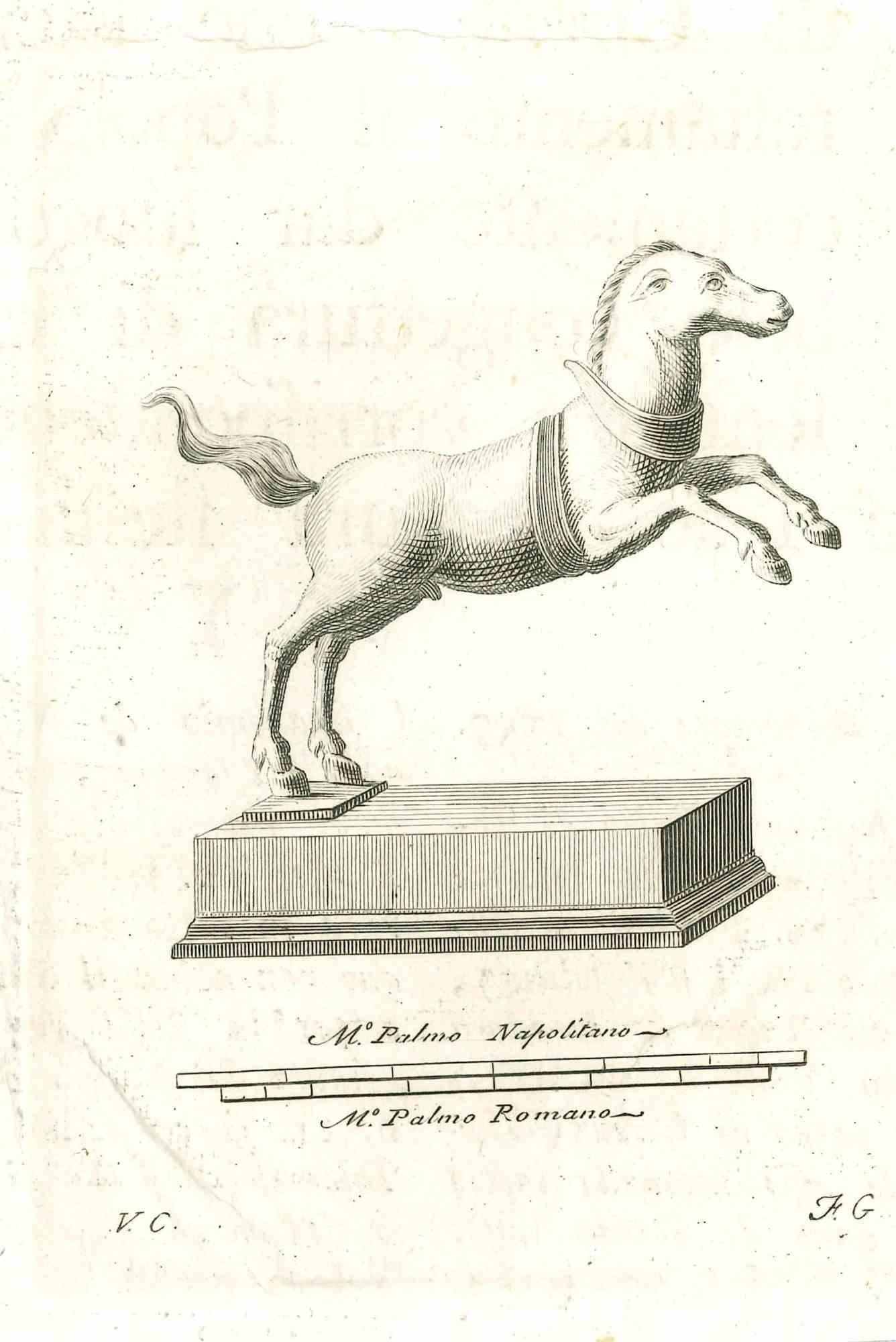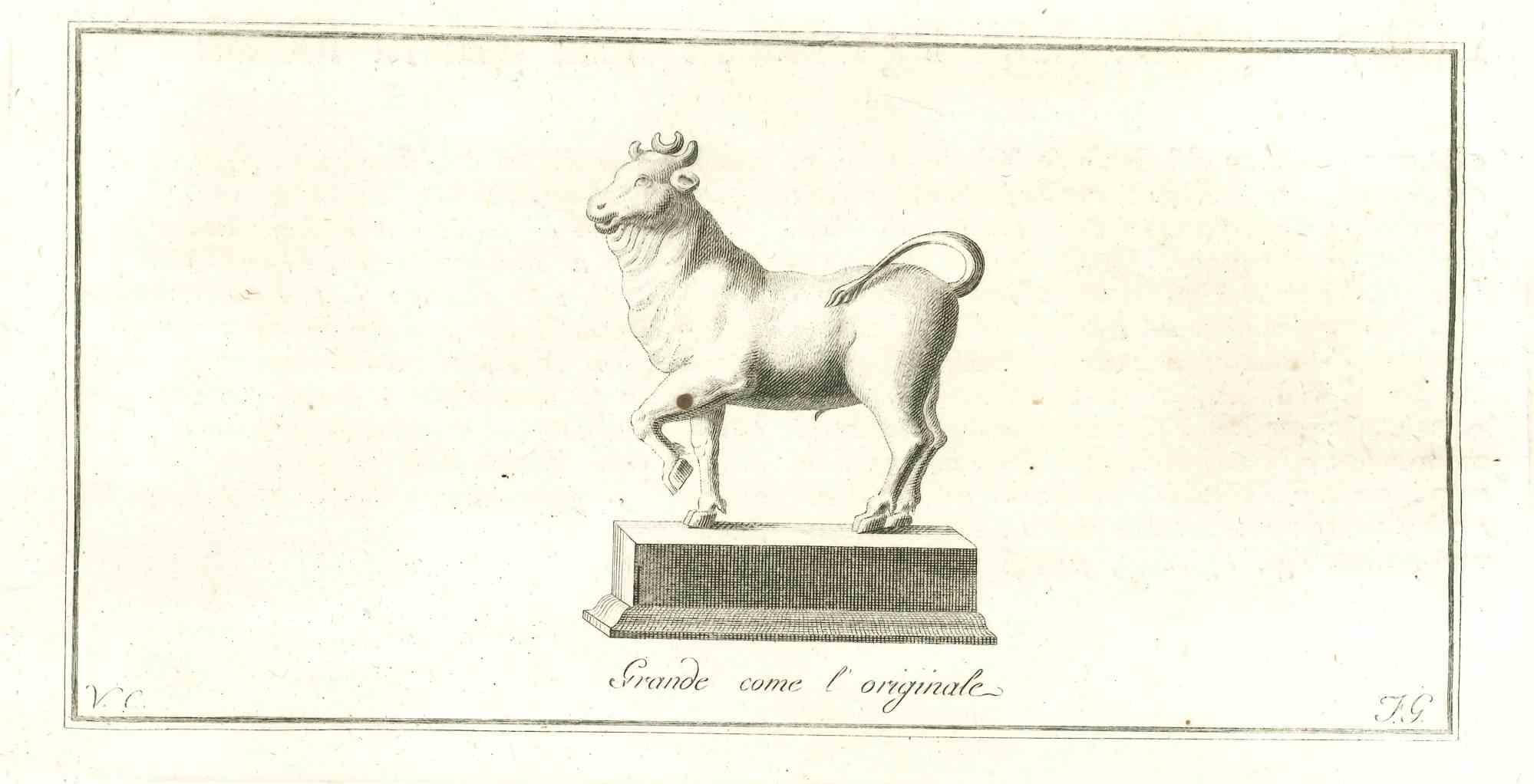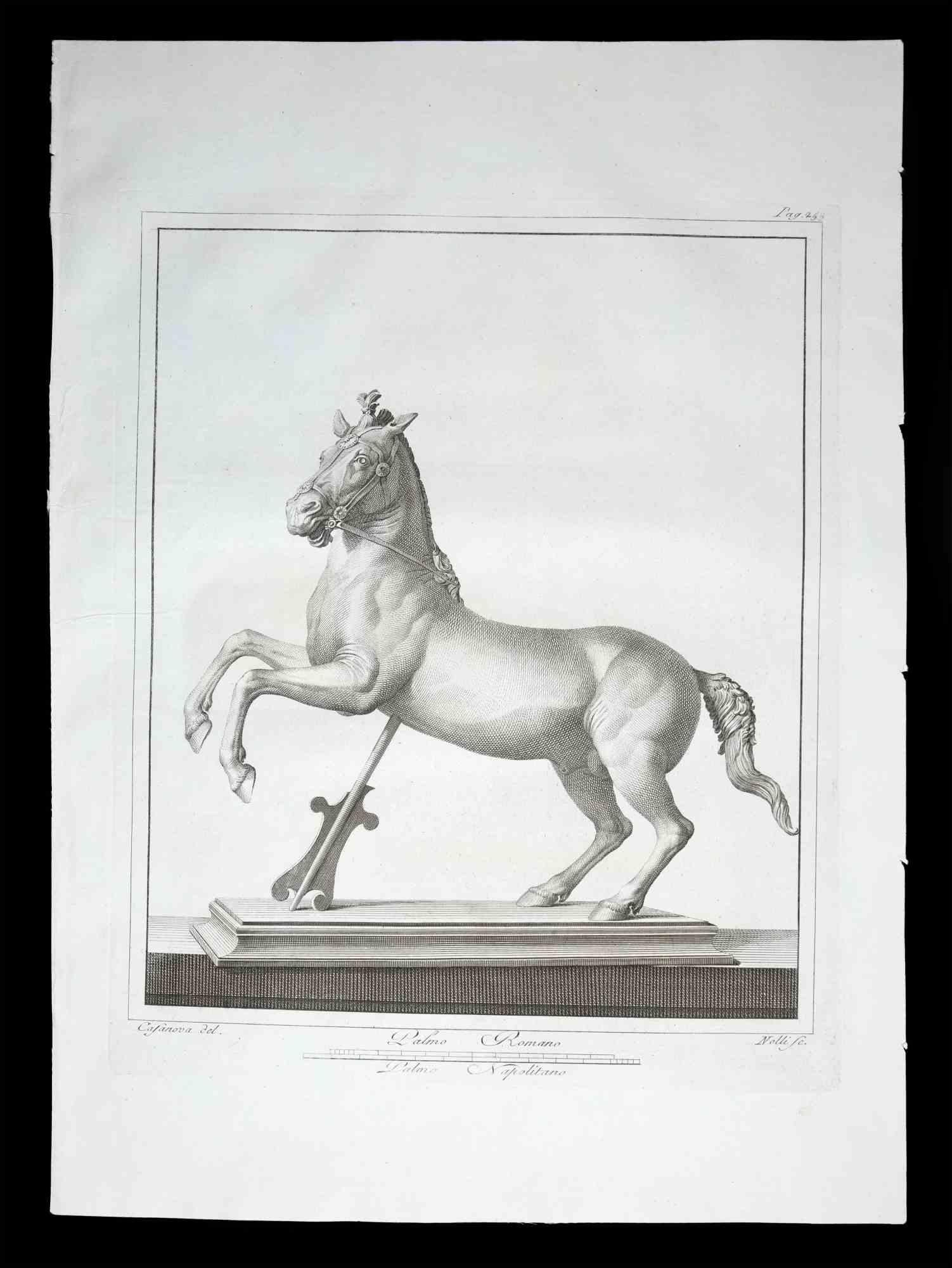Articles similaires à Antiquités d'Herculanum exposées - gravure d'origine XVIIIe siècle
Vous voulez plus d'images ou de vidéos ?
Demander au vendeur plus d'images ou de vidéos
UnknownAntiquités d'Herculanum exposées - gravure d'origine XVIIIe siècleLate 18th Century
Late 18th Century
À propos de cet article
Antiquities of Herculaneum Exposed, original etching from the end of the 18th century, made by Various Old Masters.
Bon état.
The etching belongs to the print-series Antiquities of Herculaneum Exposed (original title: Le Antichità di Ercolano Esposte), eight volumes of engravings of the finds from the excavation of the ruins of Herculaneum in the Kingdom of Naples (today Campania, Italy).
It was published between 1757 and 1792 by the Regia Stamperia and later these copies were delivered to selected recipients throughout Europe.
Despite the title, the Antiquity of Herculaneum shows objects from all the excavations undertaken by the Bourbons in the Gulf of Naples. These include Pompeii, Stabia and two sites of Herculaneum: Resina and Portici.
The Bourbon king Charles commissioned fifteen scholars to create a new “Herculaneum Academy” to study the finds and publish the results of the archaeological excavations of the sites.
The engravings are of high quality and the accompanying text shows a large scholarship.
They were made by 25 leading artists involved by the King to prepare drawings and engravings on the finds, among which we find Giovanni Elia Morghen, Carlo Nolli, Luigi Vanvitelli and Giovanni Battista Casanova.
The "Antiquity" was designed more to amaze readers with the quality of the objects in the collection of the King of Naples than to be used in research, following and increasing the interest of eighteenth-century society for classical culture and art in particular.
Through the exaltation of the classical concept of proportion and harmony, the book inspired the neoclassical movement in Europe, giving artists and decorators access to a vast workshop of Hellenistic motifs.
Ref .:
National Gallery (Washington), Mark J. Millard Architectural, IV (2000), n. 1.
L. Garcia y Garcia, Nova bibliotheca Pompeiana (2 v., 1998).
Royal Institute of British Architects, British Architectural Library ... First Printed Books, 1 (1994), no. 112.
U. Pannuti, Engravers and designers of the Royal Printing House of Naples in the 18th century: the publication of the Antiquities of Herculaneum, in Xenia antiqua, 9 (2000), p. 151-178.
V. Trombetta, The edition of The Antiquities of Herculaneum exhibited in Rendiconti of the Academy of Archeology, Letters and Fine Arts of Naples, 59 (1984), p.151-172.
- Année de création:Late 18th Century
- Dimensions:Hauteur : 12 cm (4,73 po)Largeur : 24 cm (9,45 po)Profondeur : 2 mm (0,08 po)
- Support:
- Mouvement et style:
- Période:
- Encadrement:Options d'encadrement disponibles
- État:Insurance may be requested by customers as additional service, contact us for more information.
- Adresse de la galerie:Roma, IT
- Numéro de référence:
À propos du vendeur
4,9
Vendeur Platine
agréés par des experts, ces vendeurs sont les plus expérimentés sur 1stDibs et les mieux notés par nos clients.
Vendeur 1stDibs depuis 2017
6 773 ventes sur 1stDibs
Temps de réponse habituel : 3 heures
- ExpéditionRecherche du devis...Expédition à partir de : Monaco, Monaco
- Politique des retoursCet article peut être retourné sous 14 jours à compter de la date de livraison.
Certaines parties de cette page ont été traduites automatiquement. 1stDibs ne garantit pas l'exactitude des traductions. L'anglais est la langue par défaut de ce site web.
Plus d'articles de ce vendeurTout afficher
- Statue romaine antique - gravure originale de Vincenzo Campana XVIIIe sièclePar Vincenzo CampanaStatue romaine antique, de la série "Antiquités d'Herculanum", est une gravure originale sur papier réalisée par Vincenzo Campana au XVIIIe siècle. Signé sur la plaque en bas à gau...Catégorie
Fin du XVIIIe siècle, Maîtres anciens, Estampes - Figuratif
MatériauxEau-forte
- Antiquités de l'Herculanum - gravure originale de C. Oratij - 18ème siècleAntiquités d'Herculanum exposées, gravure originale de la fin du XVIIIe siècle, réalisée par divers maîtres anciens. Signé en bas à gauche sur la plaque Carlo Oratij. Bon état et...Catégorie
Fin du XVIIIe siècle, Maîtres anciens, Estampes - Figuratif
MatériauxEau-forte
- Antiquités d'Herculanum exposées - gravure d'origine XVIIIe siècleAntiquités d'Herculanum exposées, gravure originale de la fin du XVIIIe siècle, réalisée par divers maîtres anciens. Bon état... Cette gravure appartient à la série d'estampes An...Catégorie
Fin du XVIIIe siècle, Maîtres anciens, Estampes - Figuratif
MatériauxEau-forte
- Statue romaine antique - gravure originale de Vincenzo Campana XVIIIe sièclePar Vincenzo CampanaStatue romaine antique, de la série "Antiquités d'Herculanum", est une gravure originale sur papier réalisée par Vincenzo Campana au XVIIIe siècle. Signé sur la plaque en bas à gauch...Catégorie
Fin du XVIIIe siècle, Maîtres anciens, Estampes - Figuratif
MatériauxEau-forte
- Ancienne gravure romaine Fresco Herculaneum de Vanni XVIIIe siècleFresque romaine antique de la série "Antiquités d'Herculanum", est une gravure originale sur papier réalisée par Vanni au 18ème siècle. Signé sur la plaque. Bon état sauf quelques ...Catégorie
Fin du XVIIIe siècle, Maîtres anciens, Estampes - Figuratif
MatériauxEau-forte
- Statue romaine ancienne d'un cheval - gravure originale de Carlo Nolli - années 1700Par Carlo NolliStatue romaine antique d'un cheval, de la série "Antiquités d'Herculanum", est une gravure originale sur papier réalisée par Carlo Nolli au 18ème siècle. Signé sur la plaque, en bas...Catégorie
XVIIIe siècle, Maîtres anciens, Estampes - Figuratif
MatériauxEau-forte
Suggestions
- Jour de marchéPar Marius BauerJour de marché. 1889. Eau-forte et pointe sèche. Wisselingh 42. 7 5/8 x 5 13/16 (feuille 8 3/8 x 6 3/8). Édition 100. Imprimé sur papier vergé crème. Brûlures et tonalités dans les m...Catégorie
Fin du XIXe siècle, Maîtres anciens, Estampes - Figuratif
MatériauxEau-forte
- Un conte de féesPar Marius BauerUn conte de fées. 1897. Aquarelle. Wisselingh 18. 2 3/4 x 4 3/8 (feuille 5 9/16 x 7 5/8). Edition 100, n°51. Une riche impression imprimée sur du papier vergé crème. Signé et numérot...Catégorie
Fin du XIXe siècle, Maîtres anciens, Estampes - Figuratif
MatériauxEau-forte
- « Nohubo remedio » (Il n'y avait pas de souvenir) - eau-forte et aquatinte sur papierPar Francisco Goya« Nohubo remedio » (Il n'y avait pas de souvenir) - eau-forte et aquatinte sur papier 3e ou 4e édition en gras, vers 1868-1878, avec des aquatintes brunies, des pointes sèches et de...Catégorie
années 1790, Maîtres anciens, Estampes - Figuratif
MatériauxGravure, Papier, Eau-forte, Aquatinte
- D'aprs Giuseppe Cesari (italien 1568-1640) St. George terrassant le dragonPar Giuseppe CesariArtiste : D'après Giuseppe Cesari (Italien 1568-1640) Titre : Saint Georges terrassant le dragon Médium : Giclée Fine Art Print sur papier Ilford Galerie Textured Cotton Rag 310gsm. ...Catégorie
XVIe siècle, Maîtres anciens, Estampes - Figuratif
MatériauxEncre qualité archive, Papier chiffon
- D'aprs Giuseppe Cesari (1568-1640) d'aprs St George terrassant le dragonPar Giuseppe CesariÀ propos de la peinture : Saint Georges terrassant le dragon est une peinture de genre dérivée de la légende de Saint Georges, un soldat vénéré dans le christianisme qui combat et va...Catégorie
XVIe siècle, Maîtres anciens, Estampes - Figuratif
MatériauxMétal
- Oiseaux - XXIe siècle, imprimé figuratif, noir et blanc, animauxPar Anna MikkeEdition limitée, 8/10. ANNA MIKKE (née en 1950) Elle est diplômée de l'Académie des beaux-arts de Łódź en 1975. Après l'obtention de son diplôme, elle a travaillé dans le domaine de ...Catégorie
années 2010, Autres styles artistiques, Estampes - Figuratif
MatériauxPapier, Eau-forte





